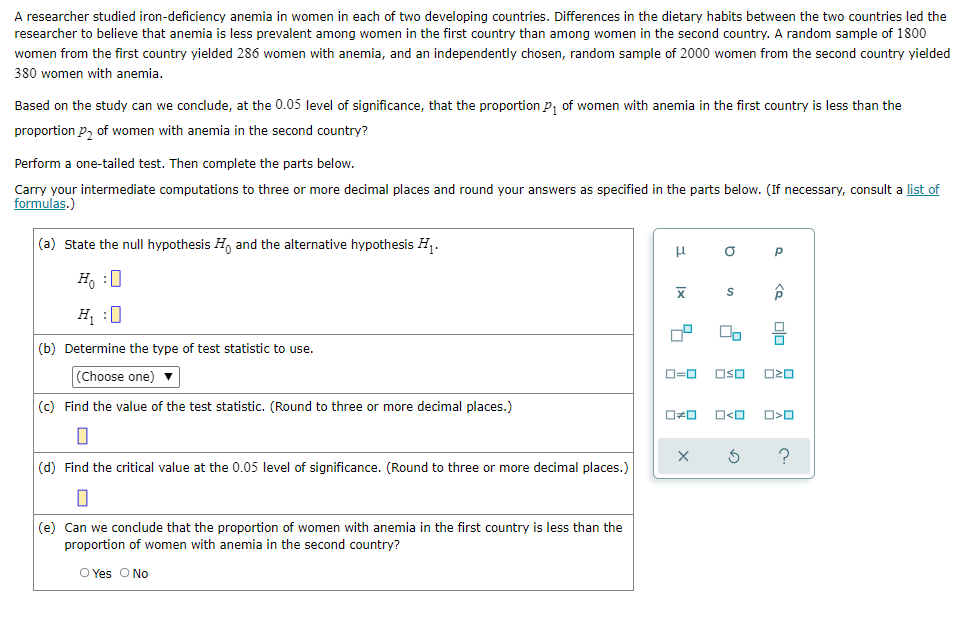A researcher studied iron-deficiency anemia in women in each of two developing countries. Differences in the dietary habits between the two countries led the researcher to believe that anemia is less prevalent among women in the first country than among women in the second country. A random sample of 1800 women from the first country yielded 286 women with anemia, and an independently chosen, random sample of 2000 women from the second country yielded 380 women with anemia. Based on the study can we conclude, at the 0.05 level of significance, that the proportion p, of women with anemia in the first country is less than the proportion p, of women with anemia in the second country? Perform a one-tailed test. Then complete the parts below. Carry your intermediate computations to three or more decimal places and round your answers as specified in the parts below. (If necessary, consult a list of formulas.) (a) State the null hypothesis H, and the alternative hypothesis H,. H, :0 H :0 (b) Determine the type of test statistic to use. (Choose one) v D=0 OSO (c) Find the value of the test statistic. (Round to three or more decimal places.) O
A researcher studied iron-deficiency anemia in women in each of two developing countries. Differences in the dietary habits between the two countries led the researcher to believe that anemia is less prevalent among women in the first country than among women in the second country. A random sample of 1800 women from the first country yielded 286 women with anemia, and an independently chosen, random sample of 2000 women from the second country yielded 380 women with anemia. Based on the study can we conclude, at the 0.05 level of significance, that the proportion p, of women with anemia in the first country is less than the proportion p, of women with anemia in the second country? Perform a one-tailed test. Then complete the parts below. Carry your intermediate computations to three or more decimal places and round your answers as specified in the parts below. (If necessary, consult a list of formulas.) (a) State the null hypothesis H, and the alternative hypothesis H,. H, :0 H :0 (b) Determine the type of test statistic to use. (Choose one) v D=0 OSO (c) Find the value of the test statistic. (Round to three or more decimal places.) O
Holt Mcdougal Larson Pre-algebra: Student Edition 2012
1st Edition
ISBN:9780547587776
Author:HOLT MCDOUGAL
Publisher:HOLT MCDOUGAL
Chapter11: Data Analysis And Probability
Section: Chapter Questions
Problem 8CR
Related questions
Question

Transcribed Image Text:A researcher studied iron-deficiency anemia in women in each of two developing countries. Differences in the dietary habits between the two countries led the
researcher to believe that anemia is less prevalent among women in the first country than among women in the second country. A random sample of 1800
women from the first country yielded 286 women with anemia, and an independently chosen, random sample of 2000 women from the second country yielded
380 women with anemia.
Based on the study can we conclude, at the 0.05 level of significance, that the proportion p, of women with anemia in the first country is less than the
proportion p, of women with anemia in the second country?
Perform a one-tailed test. Then complete the parts below.
Carry your intermediate computations to three or more decimal places and round your answers as specified in the parts below. (If necessary, consult a list of
formulas.)
(a) State the null hypothesis H, and the alternative hypothesis H,.
H, :0
H :0
(b) Determine the type of test statistic to use.
(Choose one) v
D=0
OSO
(c) Find the value of the test statistic. (Round to three or more decimal places.)
O<O
(d) Find the critical value at the 0.05 level of significance. (Round to three or more decimal places.)
(e) Can we conclude that the proportion of women with anemia in the first country is less than the
proportion of women with anemia in the second country?
O Yes O No
Ix
Expert Solution
This question has been solved!
Explore an expertly crafted, step-by-step solution for a thorough understanding of key concepts.
Step by step
Solved in 3 steps with 3 images

Recommended textbooks for you

Holt Mcdougal Larson Pre-algebra: Student Edition…
Algebra
ISBN:
9780547587776
Author:
HOLT MCDOUGAL
Publisher:
HOLT MCDOUGAL


Holt Mcdougal Larson Pre-algebra: Student Edition…
Algebra
ISBN:
9780547587776
Author:
HOLT MCDOUGAL
Publisher:
HOLT MCDOUGAL
